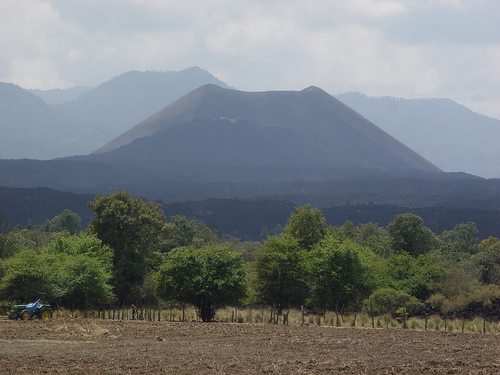Parícutin is an example of prehistory in its modern time.
- Parícutin is an unusually recent, cone-shaped volcano, and it is classified as dormant and found in Mexico’s state of Michoacán in southern North America.
- ‘Parícutin’ is also known as ‘Volcán de Parícutin’, named after the nearby village which it decimated, and it is categorised as a cinder or scoria cone volcano.
- The height of Parícutin rises 424 metres (1391 feet) above ground, and its peak sits at 2800 metres (9,186 feet) above sea level.
- The formation of the Parícutin volcano began in 1943, and was witnessed burgeoning from the ground on a private corn farm, reaching a height of 30 to 50 metres (98.5 to 164 feet) in one day, and to date, it is perhaps the most recent volcano to be created.
- Parícutin’s eruption lasted from February 1943 to early 1952, while hundreds of earthquakes, rumblings and tremors occurred before and during the eruption.
Parícutin
Image courtesy of A C/Flickr
- The creation of Parícutin was highly important in the field of volcanology, as the phenomena allowed the whole process of the formation of a cinder cone volcano to be chronicled for the first time.
- Although the Parícutin eruption occurred during World War II, it did not damper the world wide enthusiasm of the eruption, and it was even used as a background for the 1947 film Captain from Castile.
- A total area of 233 square kilometres (90 square miles) was damaged or devastated by the Parícutin eruption, and five communities were affected, two of which were destroyed by lava, while the taller parts of a church building are still visible above the hardened lava.
- Volcanic lightning was created due to the Parícutin eruption, which caused the three and only fatalities of the nine year event.
- Parícutin is popularly visited by tourists, and can only be reached directly via horse or by trekking, both of which require a guide.
Bibliography:
O’Brien J, Parícutin, n.d, Creation Ministries, http://creation.com/mount-paricutin
Parícutin, 2015, Wikipedia, http://en.wikipedia.org/wiki/Par%C3%ADcutin
Paricutin: The Volcano in the Cornfield, 2012, Musuem of Unnatural Mystery, http://www.unmuseum.org/7wonders/paricutin.htm








